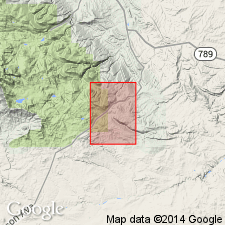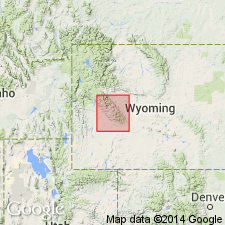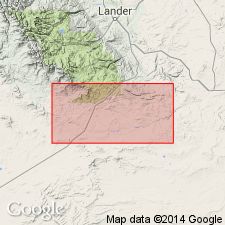
- Usage in publication:
-
- Roundtop Mountain Greenstone*
- Modifications:
-
- Named
- Dominant lithology:
-
- Greenstone
- Schist
- AAPG geologic province:
-
- Northern Rocky Mountain region
Summary:
Named for Roundtop Mountain, secs 30 and 31, T30N, R99W, its type locality, in Fremont Co, WY in Northern Rocky Mountain region. Composed of ellipsoidal greenstone, chlorite schist, chlorite-actinolite schist, and hornblende schist. Probably derived from ellipsoidal basalt. Is at least 5,000 ft thick. Shown as younger than Goldman Meadows Formation (new). Relationship with younger Miners Delight Formation (new) uncertain.
Source: GNU records (USGS DDS-6; Denver GNULEX).

- Usage in publication:
-
- Roundtop Mountain Formation*
- Modifications:
-
- Age modified
- Geochronologic dating
- AAPG geologic province:
-
- Northern Rocky Mountain region
Summary:
Miners Delight, Roundtop Mountain, and Goldman Meadows Formations shown with the oldest of the Archean rocks in a map unit called "Metasedimentary and metavolcanic rocks." Also shown as equivalent to map unit called "clinopyroxene-hornblende-biotite quartzofeldspathic gneiss" which bears a date of 3,358 +/-30 m.y. (Zr), and older than two Late Archean units which bear dates of 2,504 +/-40 m.y. to 2,575 +/-50 m.y. (using U-Pb subscript x Zr, Rb-Sr, Th-Pb, Pb-Pb and U-Pb methods) and of 2,620 +/-27 m.y. to 2,642 +/-13 m.y. (using U-Pb subscript x Zr, Rb-Sr, Th-Pb, Pb-Pb and U-Pb methods).
Source: GNU records (USGS DDS-6; Denver GNULEX).

- Usage in publication:
-
- Roundtop Mountain Greenstone
- Modifications:
-
- Overview
- Dominant lithology:
-
- Greenstone
- Schist
- Amphibolite
- AAPG geologic province:
-
- Northern Rocky Mountain region
Summary:
Is one of four formations belonging to the South Pass greenstone belt. Unconformably overlies Goldman Meadows Formation. Mapped (geologic map) in a band south of the Atlantic City iron mine, and in two exposures northeast of the mine, T29 and 30N, Rs 99 and 100 W, Fremont Co., WY in the Northern Rocky Mountain region. Consists primarily of greenstone, greenschist, and amphibolite. Mica schist, hornblende mica schist, metabasalt with lesser metagraywacke, metatuff, tremolite/actinolite schist, chlorite schist, and greenerite schist. Greenstone and greenschist at Roundtop Mountain grade into amphibolites to the southwest. Much of the formation is metamorphosed pillow basalt. The greenstones and greenschists were oceanic basalts with interlayered tuffs cut by basalt and diabase dikes. Interlayered metagraywacke near top of formation indicative of intermittent volcanic activity. Archean age. Contact of Roundtop Mountain with the younger Miners Delight Formation of the South Pass greenstone belt is a fault.
Source: GNU records (USGS DDS-6; Denver GNULEX).
For more information, please contact Nancy Stamm, Geologic Names Committee Secretary.
Asterisk (*) indicates published by U.S. Geological Survey authors.
"No current usage" (†) implies that a name has been abandoned or has fallen into disuse. Former usage and, if known, replacement name given in parentheses ( ).
Slash (/) indicates name conflicts with nomenclatural guidelines (CSN, 1933; ACSN, 1961, 1970; NACSN, 1983, 2005, 2021). May be explained within brackets ([ ]).

